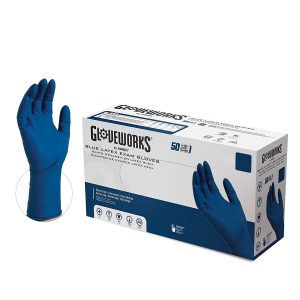The gloves you choose for hazardous chemicals can make a huge difference in your protection. What type of gloves protects your hands from hazardous chemicals the best? What are the different types of gloves available, and what do they protect against? This blog post will answer these questions and more!
What are Hazardous Chemicals?
Hazardous chemicals are materials that can cause harm to humans, animals, or the environment. They come in many different forms, including solids, liquids, and gases. Some common types of hazardous chemicals include:
- Acids
- Bases
- Organic solvents
- Inorganic salts
- Metals
Why are Hazardous Chemicals Harmful to the Body?
Some hazardous chemicals can harm the body in many different ways. For example, if you are exposed to too much acid or base your skin could burn. If you breathe in a harmful gas it may damage the respiratory system and/or cause irritation of the eyes, nose, mouth, throat, or lungs. Ingesting certain types of metals may lead to a variety of issues in different parts of the body, such as the stomach and intestines.
Type of Gloves Protects Your Hands From Hazardous Chemicals
There are many different types of gloves available to protect your hands from hazardous chemicals. Here’s a list of some common gloves and what they protect against:
1. Nitrile Gloves

Protects against organic solvents, inorganic salts, acids, bases.
2. Neoprene or Rubber Gloves

Protects against most chemicals including oil-based products and aldehydes. Can also be used to protect hands from extreme temperatures.
3. Vinyl Gloves

Protects against solvents and water-based chemicals, also protects hands from extreme temperatures.
4. Latex Gloves

Protects against most oils and acids, may not protect your hands from bases or organic solvents depending on the type of latex used to make them. Maybe a good choice for food handlers or people working with non-hazardous chemicals.
5. Disposable Gloves

Protects against most inorganic salts, organic solvents, and oils. May not be the best option for prolonged use with acids or bases because they are made of natural rubber which is more permeable than other glove materials that protect from these chemicals.
6. Electrical Gloves

Protects hands from electricity and maybe a good option for working around electrical equipment or machinery, welding, etc. Protective gloves should also be worn under these types of gloves to protect against hazardous chemicals that could get through the protective layer and onto your skin.
Comparison Table
| Gloves | Protection against chemicals |
| Nitrile Gloves | Organic solvents, inorganic salts, acids, bases |
| Neoprene or Rubber Gloves | Oil-based products and aldehydes |
| Vinyl Gloves | Solvents and water-based chemicals |
| Latex Gloves | Oils and acids |
| Disposable Gloves | Inorganic salts, organic solvents, and oils |
| Electrical Gloves | Electrical equipment or machinery, welding |
FAQ
Do I need to wear gloves when using hazardous chemicals?
This depends on the type of chemical you are working with. If it is a mild, non-irritating chemical (such as water) then no protection may be needed. However, if your job or task requires that you work around chemicals that could irritate your skin, you should always wear gloves.
What type of gloves should I wear when working with hazardous chemicals?
The best option for protecting your hands from hazardous chemicals is to use a glove made of material that is resistant to the chemical you are working with.
For example, if you are working with acid then latex gloves will not protect your hands and you should use a glove made of neoprene or rubber. If you are not sure which type of glove to use, consult with your supervisor or safety specialist.
What if I get hazardous chemicals on my gloves?
If you get hazardous chemicals on your gloves, stop working and remove the gloves immediately. Wash your hands and arms with soap and water, then dry them thoroughly. If your gloves are disposable, discard them in a safe place. If your gloves are not disposable, wash them thoroughly with soap and water, then allow them to air dry.
What is the difference between disposable gloves and reusable gloves?
Reusable gloves are made of more durable material than disposable ones. They can be worn multiple times for short periods of time (up to one hour) before they need to be replaced. Disposable gloves come in a variety of styles but most often they are made of either natural rubber or nitrile.
Finishing Touch
There are many different types of gloves available to protect your hands from hazardous chemicals. It is important that you understand which type of glove is best for the chemical(s) you will be working with so that you can properly protect yourself wh

I am not a good blogger but I started blogging when I was in my college. one day scrolling my social media pages and top of the page one notification was coming like this “ earn money from blogging”.then I clicked that notification. After that, I was confused that which niche is better for me. Finally, I selected the niche and I was comfortable with that glove’s reviewer.


Types of gloves you can refer to protect your hands from harmful chemicals. Nitrile gloves: among the toughest products that resist infectious solutions and toxic chemicals. Neoprene gloves: ideal options for mild corrosive chemicals and materials. They resist the intrusion of oils and solvents. Rubber gloves: effective protective wear that withstands mild corrosive chemicals and materials.
Thank you so much for the great article, it was fluent and to the point. Cheers.